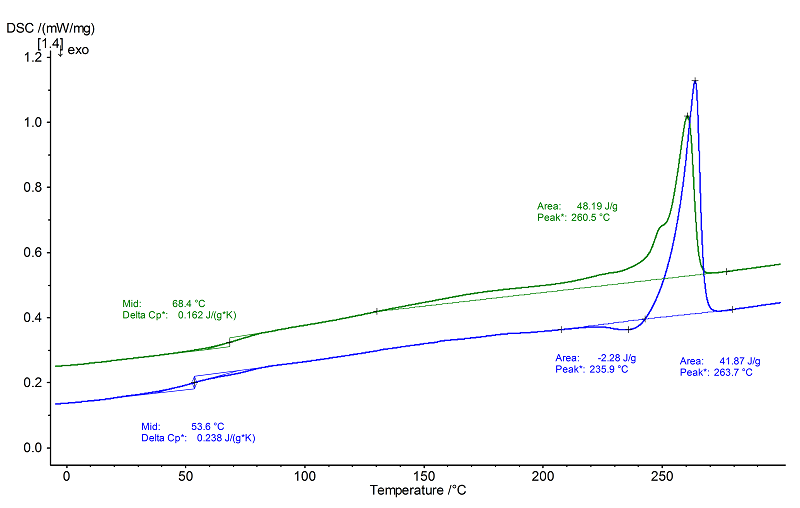PA66: Polyamide 66
- Short Name
- PA66
- Name
- Polyamide 66
- Group
- ETP - Engineering Thermoplastics
- General Properties
- Chemical Formula
- Structural Formula
-

Properties
- Glass Transition Temperature
- 65 to 90 °C
- Melting Temperature
- 225 to 265 °C
- Melting Enthalpy
- 185 J/g
- Decomposition Temperature
- 430 to 473 °C
- Young's Modulus
- 3000 MPa
- Coefficient of Linear Thermal Expansion
- 35 to 45 *10¯6/K
- Specific Heat Capacity
- 1.67 to 1.70 J/(g*K)
- Thermal Conductivity
- 0.24 to 0.33 W/(m*K)
- Density
- 1.13 to 1.16 g/cm³
- Morphology
- Semi-crystalline thermoplastic
- General properties
- Good mechanical strength. High impact strength. Good damping behavior. Good abrasion resistance
- Processing
- Injection molding
- Applications
- Mechanical, automotive and apparatus engineering, e.g., for plain gearings, gear wheels, sliding plates
Internet Links
NETZSCH Measurements
- Instrument
- DSC 204 F1 Phoenix®
- Sample Mass
- 10.15 mg
- Isothermal Phase
- 5 min
- Heating/Colling Rates
- 10 K/min
- Crucible
- Al, pierced
- Atmosphere
- N2 (50 ml/min)

Evaluation
As a semi-crystalline thermoplastic, PA6.6 showed a glass transition at 68°C (midpoint) in the 2nd heating (green) and an endothermal melting range from approx. 200°C to 270°C. As is often the case for PA6.6, a second melting transition at 250°C can be observed as a pre-peak (or shoulder) prior to the actual main melting effect with a peak temperature of 261°C. In the 1st heating (blue), post-crystallization (exothermal effect at 237°C) occurred prior to the melting peak.
The corresponding glass transition temperature in the 1st heating at 54°C (midpoint) is lower than the Tg at 68°C in the 2nd heating due to the presence of a small amount of water, as evidenced by the shallow evaporation peak between 100°C and 200°C (blue curve).
The corresponding glass transition temperature in the 1st heating at 54°C (midpoint) is lower than the Tg at 68°C in the 2nd heating due to the presence of a small amount of water, as evidenced by the shallow evaporation peak between 100°C and 200°C (blue curve).